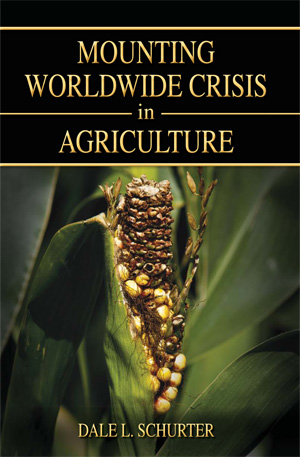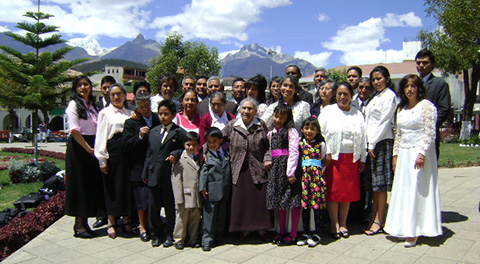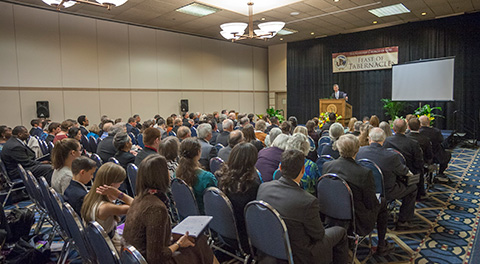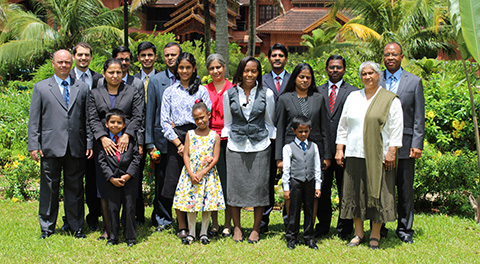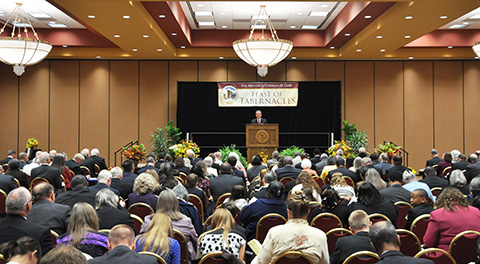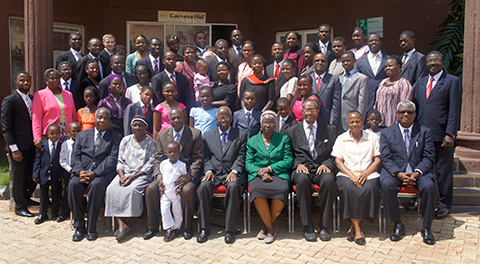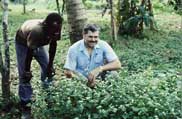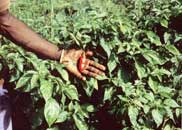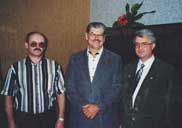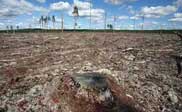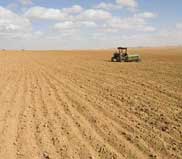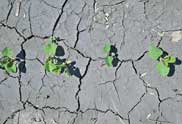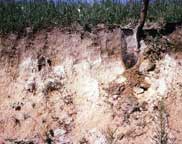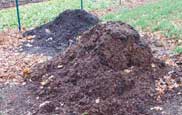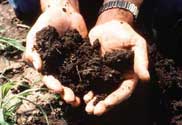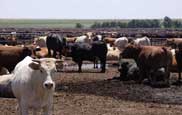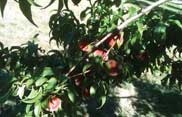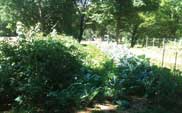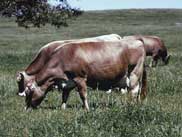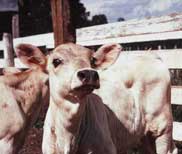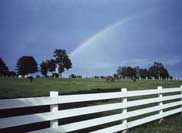Chemical warfare has long been a reality on planet Earth. Today it has become the last weapon in man’s arsenal against crop-destroying insects and weeds.
These chemicals affect not only insects, but also man himself—us! No matter who you are or where you live, the food you consume contains pesticides originally meant for insects. And now, you carry these toxic chemicals in your body.
More than a trillion pounds of pesticides have probably already accumulated and remain in Earth’s air, water, soil, living plants, and animals, and the amount grows daily. Remember, we saw earlier that 50 million tons of toxins are applied annually to soil and crops in America alone.
What these poisons are doing to the entire web of life—and to personal health—began to be known some 40 to 50 years ago. We warned at that time that unless mankind drastically changed its ways, we were headed for disaster.
And now, today, as you read these words, we are in the middle of that forecasted disaster—and are witnesses of an ever-expanding crisis!
Life Chain Threatened
The most common pesticides 40 years ago were DDT and other chlorinated hydrocarbons. In 1972, after Ms. Carson’s book Silent Spring brought the world’s attention to DDT’s adverse environmental effects, the United States and many other nations worldwide banned the application of this compound. Because of its effectiveness in fighting diseases such as malaria, however, use of DDT persists in some countries, including China.
Today, toxins from DDT and similar compounds that have replaced it are manifold, found virtually everywhere in the soil, on the soil, and in food and feed crops—from mega-farms to community landscapes, even including home lawns and flower and vegetable gardens. And this does not count those “seeded” into the clouds, which eventually find their way into the air we breathe, trees, plants, water and soil. They have become “silent” direct and indirect killers—alive and well today.
In 1996, another major instrument was added to the arsenal of destructive devices. Enter the onslaught of genetically modified organisms (GMOs), which are also called “genetically engineered” (GE) crops.
Genetics is the study of the way plants, animals and humans pass on unique characteristics to their offspring. A gene is any of the units “programmed” with these inherited features that make up a section of a chromosome. And chromosomes are tiny particles in the nucleus of cells, the basic building blocks of which are deoxyribonucleic acid (DNA). DNA stores the genetic code and passes on said characteristics.
Consider what the possible outcomes, and consequences, would be from manipulating gene code sequencing. Here are just a few brief but sobering examples (emphasis added):
• A Baylor College of Medicine study linked exposure to a component of GMO corn to infertility in rats as well as to the growth of human breast and prostate cancer cells (Environmental Health Perspectives).
• Mice fed GMO corn had lower birth rates and their offspring had lower average birth weights than a control group sustained by non-GMO corn, according to an investigation conducted by the University of Veterinary Medicine in Vienna, Austria, and the Research Institute of Organic Agriculture (sponsored by the German Federal Ministry of Education and Research).
• An Italian study found that mice exposed to feed with a 14 percent GMO content developed testicular changes, some irreversible, and were associated with diminished DNA function and cell damage (European Journal of Histochemistry).
• “Russian biologist Alexey V. Surov…and his colleagues set out to discover if Monsanto’s genetically modified (GM) soy, grown on 91% of US soybean fields, leads to problems in growth or reproduction…After feeding hamsters for two years over three generations, those on the GM diet, and especially the group on the maximum GM soy diet, showed devastating results. By the third generation, most GM soy-fed hamsters lost the ability to have babies. They also suffered slower growth, and a high mortality rate among the pups.
“And if this isn’t shocking enough, some in the third generation even had hair growing inside their mouths…” (Institute for Responsible Technology).
• In 2012, scientists from Norway reported that rats fed GM corn over a 90-day period were fatter than those fed non-GM corn. They found similar changes in fish as well, “‘These were not major changes; all were within a normal range and the fish appeared healthy,’ says [Ashild Krogdahl, a professor at the Norwegian School of Veterinary Science].
“‘But the ones who had fed on GM corn were slightly larger, they ate slightly more, their intestines had a different microstructure, they were less able to digest proteins, and there were some changes to their immune system. Blood samples also showed some change in the blood’” (ScienceNordic).
Additionally, the researchers found that genetically modified foods have much greater consequences than previously believed: “‘A frequent claim has been that new genes introduced in GM food are harmless since all genes are broken up in the intestines. But our findings show that genes can be transferred through the intestinal wall into the blood; they have been found in blood, muscle tissue and liver in sufficiently large segments to be identified,’ Krogdahl explains.
“‘The biological impact of this gene transfer is unknown.’”
And this could be called the tip of the iceberg! Are we to think that we will fare any better when exposed to the same chemicals?
A number of countries have already banned the use of GMO seeds.
In the very beginning, our Creator gave guidelines—if we have eyes to see and ears to hear—to plant seed that reproduces like-kind, “whose seed is in itself” (Genesis 1:11-12). These are sustainable and renewable. Consider. Where in this statement is license to enter the plant world—which God designed—and genetically modify them in ways that human beings think to be better?
Toxic Environment
The major pesticides in use today are vicious pollutants. Many are very stable compounds, meaning they are not easily broken down. And because of this persistence, they build up in dangerous biological concentrations in the food chain. They ultimately end up in the human body. Here is what happens:
Ocean water, for example, contains phytoplankton—the producer of over half the world’s oxygen supply and the first link in the sea’s chain of life. Not only does DDT (and similar compounds) decrease oxygen-producing photosynthesis, but it also has a tendency to accumulate in biological organisms and be passed up the food chain—from phytoplankton to zooplankton, shrimp, small fish, larger fish, and then fish-eating birds. In birds, the concentration accumulated to an astounding 10 million times the original amount present in the ocean water (Time).
Even 40 years after banning DDT, “Fish consumption advisories are in effect for DDT in many waterways including the Great Lakes ecosystem” (EPA).
Likewise on land, these poisons are extremely harmful to microorganisms and other minute forms of life and life processes in the soil.
Pesticides have virtually wiped out certain bird species by upsetting an intricate hormone-enzyme relationship, leading to thin-shelled eggs that crack and fall apart easily. They have produced fatal effects in wildlife by interrupting the communication network in animals’ nervous systems. (Keep in mind the disappearance of honey bees and so many other pollinating insects—beneficial creatures destroyed by continually expanding the application of these and other toxins.)
In Canada, marked levels of DDE—a derivative of DDT—were found in the droppings of chimney swifts (birds that often nest in chimneys) dating from 1944 to 1992, which provides clues as to why “the number of chimney swifts dropped 95% between 1968 and 2005,” Science reported.
Research indicates DDT and other chlorinated hydrocarbons cause a marked alteration in the sexual mechanisms of rats and a proneness to cancer in animals from mice to cattle. Do we dare assume humans are not affected in the same way?
Chlorinated hydrocarbons expert Dr. Charles Wurster plainly stated the dangers of these chemicals: “All are nerve poisons. They cause instability or spontaneous ‘firing’ of nerve cells, and increased doses result in tremors or convulsions—typical symptoms of acute poisoning that can occur in organisms ranging from houseflies to man. In general, if an organism has nerves, the chlorinated hydrocarbons can kill it” (Weeds, Trees, and Turf).
Shocking!
Dr. Joseph J. Hickey, professor of wildlife ecology at the University of Wisconsin, was even more direct in his book Farm Chemicals: “DDT is a chemical of extinction.” This has been public knowledge for decades—but who is listening? Are you?
In 1971, Gainsborough News published an article about a river of death in Britain: “Children and adults, attracted by tens of thousands of fish slaughtered in the River Till at Sturton-by-Stow, dice with danger if they touch them…It is one of the strongest forms of organic chemical pollution we have come across and rats and birds which have been feeding on the dead fish are being found dead along the banks…Dogs which have been drinking the water will soon follow suit and farmers have been warned to clear their livestock from the riverside. The pollution, apparently from the Ingham area, is a killer and River Authority workmen have been strongly advised not to allow either the contaminated water or the fish to come into contact with their skin.
“The sluggish black waters of the River Till have become a glistening graveyard as shoals of bream, prime roach and eels float grimly to the surface. Not a single item of river life has escaped the horror, as flies, beetles and even hedgehogs are carried motionless along the killer stretch.”
As the realization of these harmful truths expands, many around the world have already taken action against the use of DDT and chlorinated hydrocarbons in their countries. Regardless of DDT’s ban in the U.S. years ago, residual toxicity remains. This is in part because several countries from which we import food continue to use it and the chemicals wind up in our diets.
Thankfully, more nations are pursuing the elimination of DDT, including China. But what about the other substances that have taken its place?
Nerve Gases Used as Pesticide
In many areas, organic phosphorus compounds—or organophosphates—have replaced DDT and chlorinated hydrocarbons. These were originally developed in World War II as German nerve gases. Chemically, they are cousins to the nerve agents GD and VX, which are involved in the current chemical and biological warfare controversy.
Over 30 million pounds of organophosphates are being spread unchecked as pesticides on America’s farms and gardens annually (EPA).
Because these pesticides break down much more quickly than chlorinated hydrocarbons, many assume they are safer. In reality, these odorless and colorless chemicals are potentially more dangerous.
Dr. Alice Ottoboni, former California State Public Health Department toxicologist, wrote of organophosphates in the book The Dose Makes the Poison: A Plain-Language Guide to Toxicology, “A great deal of data indicate that some degradation products of nonpersistent pesticides have at least as much potential for nontarget damage as DDT.”
Small amounts can cause harm almost instantly, either by contact or ingestion.
“When DDT was banned, the use of organophosphate insecticides increased greatly. A large increase in poisoning of farm workers accompanied this increase; some poisonings were so severe as to be lethal” (ibid.).
Realize: a nonpersistent pesticide does not just “disappear” when it is broken down. “On the contrary,” Dr. Ottoboni continued, “All nonpersistent pesticides merely degrade to other chemicals! The only difference is that most of these new chemicals do not have the same pesticidal action as their parent chemicals. These new chemicals may not kill pests, but what is their toxicity to other organisms? What is their fate in the environment? Do they persist? Do they accumulate?” (emphasis added).
There is growing knowledge, however, surrounding the most common pesticide in use throughout the U.S. today—atrazine. Since its introduction in 1958, atrazine has grown to have an “estimated production of 76 [million] to 85 million pounds annually. Approximately 76.5 million pounds of active ingredient are applied domestically per year” (EPA).
This is over twice the amount of total organophosphates used!
Even more shocking is just how much is known about this pesticide and its effects. Consider this 2010 report from the Natural Resources Defense Council (NRDC): “Banned in the European Union and clearly linked to harm to wildlife and potentially to humans, the pesticide atrazine provides little benefit to offset its risks. In 2009, NRDC analyzed results of surface water and drinking water monitoring data for atrazine and found pervasive contamination of watersheds and drinking water systems across the Midwest and Southern United States.”
“Approximately 75 percent of stream water and about 40 percent of all groundwater samples from agricultural areas tested in an extensive U.S. Geological Survey study contained atrazine. NRDC found that the U.S. EPA’s inadequate monitoring systems and weak regulations have compounded the problem, allowing levels of atrazine in watersheds and drinking water to peak at extremely high concentrations.
“The most recent data confirms that atrazine continues to contaminate watersheds and drinking water. Atrazine was found in 80 percent of drinking water samples taken in 153 public water systems. All twenty watersheds sampled in 2007 and 2008 had detectable levels of atrazine, and sixteen had average concentrations above the level that has been shown to harm plants and wildlife” (ibid.).
But with so great an amount of this pesticide applied today, could the effects be as harmful as some believe?
A study released in 2010 by the University of California, Berkeley, yielded disturbing results: “Atrazine, one of the world’s most widely used pesticides, wreaks havoc with the sex lives of adult male frogs, emasculating three-quarters of them and turning one in 10 into females…”
“The 75 percent that are chemically castrated are essentially ‘dead’ because of their inability to reproduce in the wild, reports UC Berkeley’s Tyrone B. Hayes, professor of integrative biology.
“‘These male frogs are missing testosterone and all the things that testosterone controls, including sperm. So their fertility is as low as 10 percent in some cases, and that is only if we isolate those animals and pair them with females,’ he said. ‘In an environment where they are competing with unexposed animals, they have zero chance of reproducing.’”
Environmental chemicals that enter into our bodies, whether by air, food or water, will affect us. An article published by rodale.com recorded some of these effects: “Researchers from the Baylor College of Medicine compared rates of a rare birth defect called choanal atresia—which happens when the cavity between a baby’s nose and mouth becomes fully or partially closed and causes breathing problems that can be fatal—to application rates of the herbicide atrazine in Texas farm fields.
“The results: Birth defect rates and atrazine application levels went hand-in-hand, says lead study author Philip Lupo, PhD, assistant professor in the department of pediatrics. Women living in counties with the lowest rates of pesticide application had relatively no risk of having babies with this specific birth defect, he says. ‘But as you go up to the next group—areas with medium levels of atrazine application—there was almost a 40% increase in risk. Moms in counties with the highest levels saw an 80% risk,’ he says.
“That should raise red flags, even if you’re not planning to have children any time soon. Lupo says that the only known risk factor for choanal atresia is thyroid-medication use during pregnancy. But, according to the birth records he used in his analysis, very few of the mothers had been diagnosed with thyroid problems or were taking thyroid medications, which means your body could be reacting to the herbicide the same way it would to a thyroid medication or thyroid abnormality.
“If atrazine is messing with thyroid hormones, the herbicide could play a bigger role in other health problems, according to research done by the Endocrine Society. Chemicals that interfere with thyroid hormones have been linked to metabolic disorders, and thus could be playing a role in diabetes and obesity, as well as in autoimmune disorders and cardiovascular disease.”
To curb the effects of pesticides on crops, farmers in the U.S. came to broadly endorse the genetic engineering of agriculture. So much so that “herbicide-tolerant crops accounted for 93 percent of U.S. soybean acreage, 78 percent of cotton acreage, and 70 percent of corn acreage in 2010” (USDA, emphasis added).
In addition to herbicide-tolerance, plant genetics are also manipulated to be resistant to insects. One popular crop contains “the gene from the soil bacterium Bt (Bacillus thuringiensis)…[producing] a protein that is toxic to specific insects. Plantings of Bt crops accounted for 73 percent of U.S. cotton acreage and 63 percent of corn acreage in 2010” (ibid., emphasis added).
Although the use of Bt crops has reduced the application of insecticides, Dr. Ottoboni wrote in her book The Dose Makes the Poison that “BT’s usefulness is limited to certain classes of insects, and it is harmful to all butterflies and moths. Additionally, some chemically sensitive people believe that they respond just as severely to BT as to other pesticides” (emphasis added).
Adding to the concern, a study released in 2011 found that the toxin produced by the Bt bacterium was present in the blood of 93 percent of pregnant mothers and 80 percent of their babies as well as 69 percent of women who were not pregnant (Reproductive Toxicology).
The distressing fact, outside of the ecological effects, is that pesticides have not eliminated insect infestation and crop loss—and are actually creating new problems.
Charles Benbrook, a research professor at the Center for Sustaining Agriculture and Natural Resources at Washington State University, told Reuters, “…the introduction of ‘Bt’ corn and cotton crops engineered to be toxic to certain insects is triggering the rise of insects resistant to the crop toxin.”
“Insecticide use did drop substantially—28 percent from 1996 to 2011—but is now on the rise, he said.
“‘The relatively recent emergence and spread of insect populations resistant to the Bt toxins expressed in Bt corn and cotton has started to increase insecticide use, and will continue to do so,’ he said.
“Herbicide-tolerant and Bt-transgenic crops now dominate U.S. agriculture, accounting for about one in every two acres of harvested cropland, and around 95 percent of soybean and cotton acres, and over 85 percent of corn acres.
“‘Things are getting worse, fast,’ said Benbrook in an interview. ‘In order to deal with rapidly spreading resistant weeds, farmers are being forced to expand use of older, higher-risk herbicides. To stop corn and cotton insects from developing resistance to Bt, farmers planting Bt crops are being asked to spray the insecticides that Bt corn and cotton were designed to displace.’”
Devastation and loss of agriculture is not exclusive to the United States—or to this century.
In 1973, “Annual loss…in Latin America alone [reached] the staggering level of 40 per cent of the total crop, while in the middle of Africa half of the sorghum [was] eaten away by insects during a single year’s storage. Similarly, an enormous amount of rice [was] lost every season in Asia because farmers [did not] find it worth their while to dry the rice—losses [were] estimated by the FAO [UN’s Food and Agriculture Organization] at three million tons each year. Mishandling of food in storage and transit also [caused] grievous waste. For instance, birds pecking holes into grain bags…ruined up to three-fourths of the contents; other local predators, such as rats and locusts, have taken their toll” (The Saturday Review).
Another source from that era stated, “In India insects annually consume more food than the entire nine million population of Michigan eats. Such losses can doubtless be reduced, but there is good reason to tone down generous promises about what can be achieved along these lines when similar conditions can be recorded also in countries where man has created powerful chemical barriers around his lush fields and even resorted to war gases in his fight for victory and survival. Nevertheless, the U.S. Department of Agriculture estimates that merely the insects cause losses to our nation in the range of four to five billion dollars annually. Our total agricultural production is valued at only six times that amount” (Too Many: A Study of Earth’s Biological Limitations).
Though we have increased pesticides and genetically modified crops enormously since then, the rate of agricultural loss due to insects remains about the same.
A sobering example of just one crop was reported in Cotton Farming: “No matter how much progress is made in the ongoing fight against cotton insect pests, the damage incurred each year remains significant, according to the 2010 Cotton Insect Loss report compiled by Michael Williams, Mississippi State University entomologist emeritus.
“Of all the detailed statistics contained in this report, the most revealing may be the fact that 8.1 million cotton acres across the Belt were infested by the bollworm/budworm insect complex, resulting in 263,902 bales lost.”
“When translated into economic losses for cotton production…the total yield loss due to insects across the Belt adds up to $376,673,521, or an average of $35.33 per acre.”
Another major problem with using pesticides is that predators of the pest are often killed along with the target. Since these natural enemies have been partially successful in controlling the pest population, wiping them out temporarily leaves the primary offender free of important natural restraints.
Under these circumstances, the pest will develop a resistance through mutation and multiply before natural enemies can multiply to control them.
Thus insects’ resistance to pesticides is a mounting worldwide problem. Between 1908 and 1945, only 13 species of insects had developed resistance. Now, according to the FAO, the figure stands at over 700!
The current practice employed to control these hardy new pests is to develop more potent pesticides. But instead of controlling or killing an insect, a vicious cycle is created—stronger insects, more toxic pesticides, and an increasing threat to all life forms on this planet. And the vast majority still refuse to address the fundamental cause! They seem bound and determined to continue and expand more of the same husbandry practices that caused the problem in the first place.
And their use is once again on the rise: “Genetically engineered crops have led to an increase in overall pesticide use, by 404 million pounds from the time they were introduced in 1996 through 2011, according to the report by Charles Benbrook…” (Reuters).
This is due in part to the rise of herbicide-resistant weed species, referred to as “superweeds.” Mr. Benbrook also stated in the article, “Resistant weeds have become a major problem for many farmers reliant on GE [genetically engineered] crops, and are now driving up the volume of herbicide needed each year by about 25 percent.”
The proposed answer? “Scientists say the solution to the widespread resistance problem is a new type of GM that uses a powerful weedkiller that was once part of Agent Orange, the defoliant widely used during the Vietnam war” (BBC). Again, shocking! Should we not be addressing the cause of insects?—trying a little prevention?
No Way Out?
Here then is where scientists and farmers see a problem: we are told that “crop and livestock production in the United States would drop by 25 to 30 percent”—that commercial production of apples, peaches, cherries, grapes, cranberries, raspberries, strawberries, citrus and a host of other products would come to a halt—“and prices of agricultural products would increase by 50 to 75 percent, if pesticides were completely withdrawn from use” (The World Bank Development Research Group). According to these numbers, millions would have their diets drastically altered or reduced.
Yet this data flies in the face of numerous documented cases of farmers who have stopped using insecticides and have fared better than their neighbors who continued to use these poisons.
As I wrote some 40 years ago, “If we continue to use non-biodegradable pesticides we will be in deep trouble.” And now, we are in deep trouble!
Not only is pollution reaching critical proportions, but as insects continue to develop resistance faster than new pesticides are produced, it is just a matter of time until these creatures begin to destroy food crops wholesale. And mankind will be utterly unable to stop them!
Some look to biological control—natural pesticides taken from animals, plants, bacteria and certain minerals—to provide an out. But so little money and effort is being spent on research in this area—and progress comes so slowly, if this ever even materializes—that it appears to be a false hope. In addition, there are whole categories of pest problems with no remote prospect of biological control.
Have we painted ourselves into a corner? Is there no way out? Is there no way that insect plagues can be stopped without using pesticides?
Role of Insects
Let’s continue by asking some basic questions—and finding some simple, yet profound, answers. Do insects have a purpose? What causes insects to attack plants and become “pests”? Few seem to know.
Insects constitute 70 to 80 percent of all animal species. They are so numerous that no one knows how many species there really are. More than 800,000 have already been classified and about 10,000 more are classified annually. While there are seven billion humans on Earth, there are on average three billion insects on every square mile of the planet!
Insects multiply rapidly. A single pair of flies is potentially capable of producing 191,000,000,000,000,000,000 (191 quintillion) offspring in just six months! If they all survived, the earth would be covered to a depth of 47 feet!
This cannot happen, though, because natural laws never permit a single species, plant or animal, to completely dominate any environment. Weather factors—such as temperature and rainfall—limit the distribution of an insect species. Toads, lizards, frogs, moles, snakes, birds, bats, shrews and other creatures feed largely on insects. Some birds eat their own weight in insects every day. Predatory insects prey on other insects. Larvae of parasitic insects develop in the eggs, young or adults of other insects. Viruses, fungi and bacterial diseases also help control the insect population.
In fact, if insects were not kept in check by these natural (that is, created) forces, it is doubtful whether any conceivable volume of chemicals could possibly keep their populations down. Yet we are seldom aware of these created controls that protect and serve us.
All these natural checks do their work without threatening man. Insecticides, which contribute only a very small part of the total controlling force over harmful insects, are threatening to all life. Does it not make sense for man to encourage the inherent balance, rather than devastate the natural controls?
It is not generally realized that less than 0.5 percent of insect species are considered pests to man. But crop loss due to these pests accounts for one-fifth of the world’s annual crop production (FAO). The positive benefits of insects are often overlooked because they are more difficult to estimate.
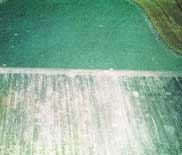
Fields of green: An aerial shot of farmland south of Dallas, Texas, shows the difference between two cotton fields, which were planted the same day with the same seed stock, on a farmer’s property who was consulting with Ambassador College agriculture personnel.
Source: The Restored Church of God
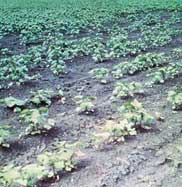
Fields of green: Close-up photo of the cotton field which used conventional fertility growing methods.
Source: The Restored Church of God
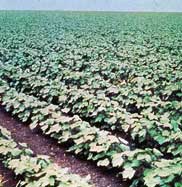
Fields of green: Close-up photo of the cotton field which used Ambassador College’s biological and mineral balancing program. Notice that these plants are much fuller. It was a very dry growing season and much of the difference is due to better moisture retention and deeper root growth.
Source: The Restored Church of God
It is easy to forget that bees, wasps, flies, butterflies and other insects pollinate plants that provide us with fruits and vegetables. Among the top likely factors for Colony Collapse Disorder, which causes sudden and complete destruction of beehives, are pesticides such as miticides and fungicides, as well as genetically modified crops.
In addition, some insects are vital links in the food chains of fish, birds and land animals—others act as scavengers of animal and vegetable debris and others as aerators of soil—still others are parasites or predators of damaging insects.
Instead of studying the habits of insects and implementing natural control methods, however, many now simply mow them down with spray guns.
For the most part, the function of “harmful” insects is all too little understood. Now, thankfully, some few scientists are beginning to realize the relationship between soil fertility, crop production, and pests.
Why Insect “Pests”?
In his landmark book, An Agricultural Testament, the famous British agriculturist Sir Albert Howard related how in five years’ time at a research station in India he “had learnt how to grow healthy crops, practically free from disease, without the slightest help from mycologists, entomologists, bacteriologists, agricultural chemists, statisticians, clearing-houses of information, artificial manures, spraying machines, insecticides, fungicides, germicides, and all the other expensive paraphernalia of the modern Experiment Station.”
Sir Albert worked with the principles any small farmer could use economically. From his experience, he observed that: “Insects and fungi are not the real cause of plant diseases but only attack unsuitable varieties or crops imperfectly grown. Their true role is that of censors for pointing out the crops that are improperly nourished and so keeping our agriculture up to the mark. In other words, the pests must be looked upon as Nature’s professors of agriculture: as an integral portion of any rational system of farming.
“The policy of protecting crops from pests by means of sprays, powders, and so forth is unscientific and unsound as, even when successful, such procedure merely preserves the unfit and obscures the real problem—how to grow healthy crops.”
These conclusions are not dreams of a man who failed. Sir Albert was knighted for this very agricultural research—for effectively proving the usefulness of the system.
Many who have worked with the soil have noticed the tendency of insects to prefer plants that are weak, sickly, unhealthy, unbalanced or just a little “under the weather.”
This deficiency or imbalance may be so subtle or slight that it cannot be measured or analyzed by present scientific methods. But it does exist. And the bugs know it!
Now take the cause-effect relationship one step further. What is it that causes plants to be weak and inferior—prone to insect attack?
Substandard Plants
A number of factors may cause weak and inferior plants—poor seed, moisture levels (too much or too little), temperature, climate, etc. But one of the most important factors is plant malnutrition caused by unbalanced soil.
In 1974, professional soil consultant for Brookside Laboratories of New Knoxville, Ohio, Martin H. Augustin stated in a personal letter: “We are proving today that sick soils produce sick plants and sick plants produce sick animals and humans. There are about one hundred of us who work with about 10,000 farmers at the present time. The overwhelming majority of them have already discovered that in a truly healthy soil our crops are not attacked by insects because God created these pests to destroy sick plants so that they cannot reproduce themselves.”
Insects serve a vital purpose as guardians and supporters of our health and well-being. Many pollinate vast numbers of food crops, flowers, trees, shrubs, provide honey, etc., while others consume and destroy sick, unhealthy plants and trees so that humans, birds and animals do not eat them and themselves get sick. But we go to war with the insects by using pesticides, destroying both the “good” with the perceived “bad.”
In times past, this interrelationship of soil, plants and insects was recognized. In 1870, American journalist Horace Greeley reported: “I hold that [insect] multiplication and their devastations are largely incited by the degeneracy of our plants caused by the badness of our culture.” Later he stated, “I heard little of insect ravages in the wheat-fields of Western New-York throughout the first thirty years of this century; but, when crop after crop of Wheat had been taken from the same fields until they had been well nigh exhausted of their Wheat-forming elements, we began to hear of the desolation wrought by insects…” (What I Know of Farming).
Mr. Greeley had understanding that most seem to lack today. In this day and age, so few see any relationship between our depleted soils, the use of incomplete synthetic fertilizers, and the alarming increase in insect pests. Unsustainable tillage and cropping methods continue to contribute to this growing problem of soil infertility and bug invasions. Our good stewardship, or lack thereof, is witnessed by its fruits—good or bad.
It is to our shame that most agricultural institutions of the “modern” era have been preoccupied with research dealing with effect-driven palliatives such as pesticides—which make the problem appear less severe or painful, but do not effect a cure. Should we not rather be performing judicious research into how to correct the cause of insect pests?
“Various studies have shown that if the soil fertility is good, then the resistance to insects is high,” Dr. Stig Erlander demonstrated in his article published by the German scientific journal Starch/Starke in 1970. “Thus [Dr. William Albrecht] has shown that spinach grown in fertile soil resisted the attack of thrips [winged insects], whereas that grown on poor soil was destroyed by these insects. A deficiency of phosphorus or magnesium produced tomatoes which were susceptible to the greenhouse white fly, whereas those grown on good soil were not. Moreover, corn can be destroyed by chinch bugs when a deficiency of nitrogen occurs. But if the amount of nitrogen is too plentiful, then the grass becomes deficient and is subjected to damage by bugs.
“It can be concluded from the above that a change in the composition of the soil may lead to genetic changes which could alter the structure of the cell wall or other constituents such as the starch granule. Moreover, good soil fertility will produce plants which are resistant to insects, viruses or detrimental worms. Genetic variations produced by radiation only eliminate specific enzymes or protein structures and hence weaken the plant. Unlike natural mutations, they may not allow the plant to return to its original state when soil conditions change. The best method for producing insect-resistant crops is thus soil fertility and not induced mutations which no doubt will eventually be [disastrous].”
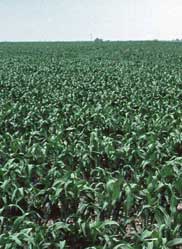
Compare and contrast: Sample crop of hay grazer in eastern Texas grown using Ambassador College’s soil treatment program.
Source: The Restored Church of God
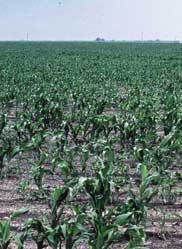
Compare and contrast: Sample crop of conventionally grown hay grazer in eastern Texas.
Source: The Restored Church of God
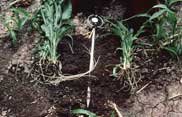
Compare and contrast: Two sample crops of hay grazer in eastern Texas were planted on the same day using the same seed to demonstrate a vast difference in results. Due to extended drought after planting and lack of the soil’s friability, the soil’s hardness prohibited the roots on the right from penetrating deeply into the soil. In contrast, the roots on the left grew in healthy soil, which meant the plant’s roots could grow much deeper to extract the needed water and nutrients for proper growth. A penetrometer, which measures the permeability of the soil, rests in between uprooted samples from both fields that demonstrate the effectiveness of the AC treatment.
Source: The Restored Church of God
In January 2012, scientists from Arizona State University and the Chinese Academy of Sciences published a report directly linking land management practices with modern-day locust swarms. Like chinch bugs, locusts also thrive and multiply on plants low in nitrogen, such as those from heavily grazed plots, and can “populate over 20 percent of the Earth’s land surface, negatively affecting more than 60 countries” during an outbreak year (ASU News).
Work done at the University of Florida shows that both the rate and the source of nitrogen have a pronounced effect on the susceptibility of grass to chinch bug damage. Grass receiving high rates of inorganic nitrogen was severely damaged by the bugs, in contrast with the grass receiving nitrogen from an organic source (Florida Turf Grass Association Bulletin).
Haughley Research Farms in England, established in 1939 and now under the world-renowned Soil Association, found in actual practice that crops grown on soil built up by natural manures were much more resistant to pest-inviting weaknesses than crops grown with the aid of chemicals.
In the article “Pesticides Poison Us,” “Dr. William Albrecht, [former] chairman of the Department of Soils at Missouri University College of Agriculture, and other investigators have shown that unhealthy plants are more subject to insect attack than are healthy plants. This is nature’s way of eliminating sick plants which should be returned to the earth instead of being eaten by humans.”
We observed the same result in our Ambassador College Agricultural Research Program. Even under the best conditions, insects destroyed a small percentage of the crop. But is this in itself bad? The loss of the weakest part of the crop ensures the food value of the remaining part and that the best seed is saved for the next crop.
You would think that the prospect of growing quality products that resist insects and render pesticides unnecessary would cause great excitement. But not so! This solution—the only real solution—runs counter to the greed of human nature and the vested interests of our social and economic systems. And it appears that man would rather perish than change that!
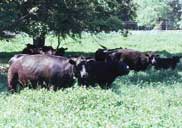
Before and after: After applying soil-building principles taught at Ambassador College, a struggling 70-acre pasture (above) is transformed into a flourishing meadow able to support one cow-calf unit of black Angus cattle on less than one acre (below). Green pastures were then able to be maintained throughout the year.
Source: The Restored Church of God

Source: The Restored Church of God
Monoculture Upsets Natural Balance
Without interference by man, Earth’s soil always produces varied, diverse crops. Yet in some areas of our modern world, it is a rare sight to see mixed crops growing together.
Monoculture reduces soil quality and will attract abnormal amounts of insects. The greater the area under one crop, and the extent to which that crop is grown exclusively year after year, the greater the potential insect problem. This practice of husbandry extracts the same variety of a host of minerals from the soil year after year, without replenishing them. Thus the mineral-deficient plants invite the insects.
The Colorado beetle is an example of what happens when man begins to simplify agriculture and farm one crop exclusively. This beetle used to be harmless and fed principally on smartweed, which it hunted out from among many other plants. When huge fields of potatoes were newly introduced to Colorado, however, this insect suddenly found itself in the midst of mile after mile of green potato fields—a beetle’s “paradise.” As a result, the beetle multiplied so rapidly that within little over a decade it literally ate its way over 1,600 miles to the East Coast!
Many similar examples could be cited, and from all parts of the planet. Regrettably, our entire modern farming method is geared toward extensive monoculture. To many it would be unthinkable to even suggest that this practice be changed! There are those, however, who have successfully changed of their own free will, and with positive results.
Other sound principles of agriculture that farmers often neglect include rotating crops to minimize insect reproduction, and observing the correct time for planting and growing trees and hedges, which encourage insect-eating birds to visit a farm.
Weeds and Herbicides
According to some estimates, U.S. crop losses from weeds have been equal to the combined losses from insects and diseases, and run second only to those caused by soil erosion.
Alfred H. Krebs recorded in 1964 in his book Agriculture in Our Lives, “Some persons who have studied the matter estimate that weeds cause an annual loss of about five billion dollars to farmers in the United States. The average loss per farm is probably over a thousand dollars, most of which is in the form of crop damage. Some experts have placed the losses from weeds at a minimum of ten dollars per acre. The losses caused by weeds are considerably more than the losses from either crop diseases or insects.” These dollar figures would be multiplied more than seven times by 2012!
As weeds become stronger, heartier and resistant to current herbicides, more toxic compounds are being produced by the giant chemical industry. It is devising ever more powerful methods to kill weeds and beneficial soil life, and never coming to (or perhaps willingly ignoring) the true knowledge of the cause of weeds. So we see here the same vicious cycle as with all forms of pesticides.
Purpose of Weeds
As with insect pests, few seem to realize that weeds have a purpose. In the publisher’s preface to Joseph Cocannouer’s book Weeds, Guardians of the Soil, the publisher summarizes some of the purposes of weeds:
“1. They bring minerals, especially those which have been depleted, up from the subsoil to the topsoil and make them available to crops. This is particularly important with regard to trace elements.
“2. When used in crop rotation they break up hardpans and allow subsequent crop roots to feed deeply.
“3. They fiberize and condition the soil and provide a good environment for the minute but important animal and plant life that make any soil productive.
“4. They are good indicators of soil condition, both as to variety of weed present and to condition of the individual plant. Certain weeds appear when certain deficiencies occur.
“5. Weeds are deep divers and feeders and through soil capillarity they enable the less hardy, surface feeding crops to withstand drought better than the crop alone could.
“6. As companion crops they enable our domesticated plants to get their roots to otherwise unavailable food.
“7. Weeds store up minerals and nutrients that would be washed, blown or leached away from bare ground and keep them readily available.”
Obviously, these purposes and benefits are listed only as general guidelines and do not apply to all weeds under all conditions.
F.C. King, in his book The Weed Problem: A New Approach, also revealed that weeds build up and protect the soil and, coexisting with domestic crops, help make soil nutrients more available. The author stated that “we are hopelessly wrong in believing weeds to be useless plants and in devoting our energy to their suppression, instead of studying to employ them.”
In England, it has been reported that when lawns become deficient in lime, daisies appear. The daisies are found to be rich in lime, which they manufacture in their tissues. The lime goes into the soil when the daisies die and decay. When the soil becomes sufficiently enriched with lime, the daisy “problem” disappears.
When weeds become so abundant that they interfere with crop production, it ought to be recognized that the cause of the problem is not the weeds, but the depleted soil that the weeds were created and designed to protect and build up! Instead of destroying such weeds wholesale with herbicides while our soil continues to be degraded, we need to get busy building up the soil so weeds will naturally reduce themselves.
Solving the Problem
Here, then, is where we stand in regard to the pollution problem caused by pesticides such as herbicides and related chemicals.
Is it possible to survive if we continue to use ever-stronger chemicals in ever-greater quantities? No!
Is it possible to survive if we quit using pesticides? Yes! Many farms—large and small—are successfully doing it!
Will this be easy? For many, no! This is because the solution to the problem is to restore balanced fertility to the soil. And as Professor Cocannouer well stated in Farming with Nature, “The trouble is that most people refuse to learn just what farming [within the guidelines of nature] really is. Anything or any operation which enhances the activities in the soil’s workshop is farming with Nature. But merely speeding up those activities is not necessarily enhancing them.”
“Bringing a piece of land back to permanent fertility is probably the most difficult of all farm operations. Too often the farmer fails to make a go of his soil building because he doesn’t acquaint himself thoroughly, before starting, with all the adverse factors he is going to have to fight. He gets discouraged because he does not see the size of the job of remaking land that has been weakened for fifty or a hundred years. He has more than likely been schooled to expect the quick response that land makes to stimulants. He forgets that now he is building for permanency, not merely stimulating” (Weeds, Guardians of the Soil, emphasis added).
But it can be done and is being accomplished on an expanding number of farms, orchards and vineyards. This includes through Ambassador Center’s Agriculture Education and Research Institute (AERI) and its extension programs.
Obviously the biggest hurdle will be changing our attitudes and accepting that the way to success is to work with natural laws rather than defying them.
A crash program in research and education on restoration methods—dealing with cause, not effect—needs to be carried out on a grand scale immediately, and administered by the highest-level governmental agencies, in order to make a significant and successful transition on a national level. (The reader should ask: is this likely to happen?) Again, however, each of us individually is responsible for the choices we make and actions we take.
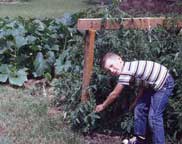
Bountiful harvest:?This thriving backyard vegetable garden for a family of four in Big Sandy, Texas, demonstrates that anyone who employs correct methods of gardening can reap high yields.
Source: The Restored Church of God

Winter vegetables:?Collard greens and kale grow in a raised bed in Wadsworth, Ohio. The organic garden is a local extension of the Agriculture Education and Research Institute.
Source: The Restored Church of God
Through years of eye-opening education, research and production in the Agriculture Division of Ambassador College, Big Sandy, Texas—without using any toxic chemical herbicides, GMOs, etc.—we proved beyond the shadow of a doubt it can be done, and with rewarding success. And we continue to do so through the AERI. Healthier soil, healthier plants, and healthier animals equal healthier people!
I, my co-workers, and many of the program’s graduates have personally taught and continue to teach these methods. All have their underpinnings in the principles of the Bible and are backed up by the laws of biogenesis, physics and chemistry. These programs focus on carefully following the instructions and guidelines of Scripture, and then practicing them.
In doing so, we have proven the Bible’s way works and is best…every time.



